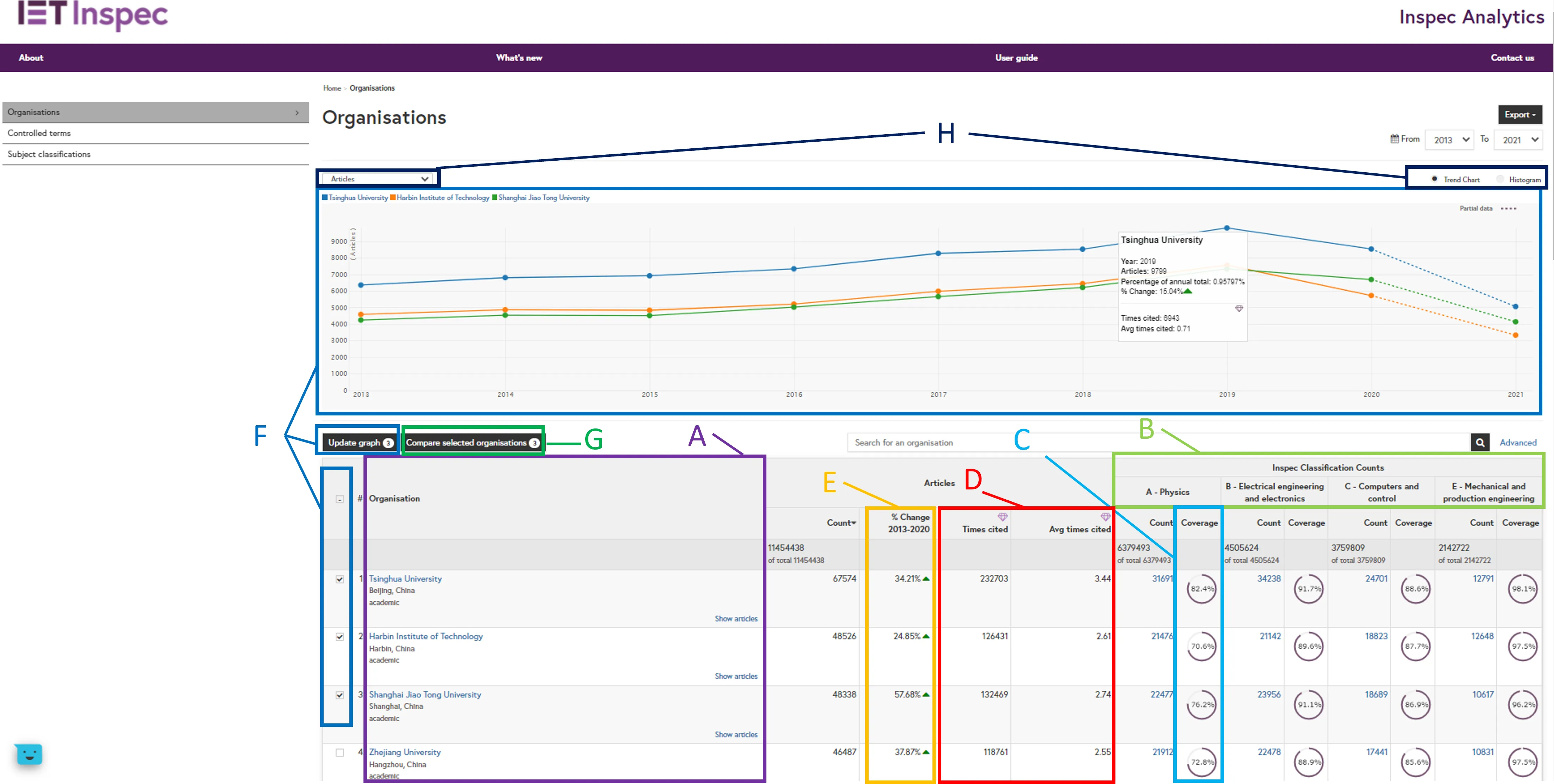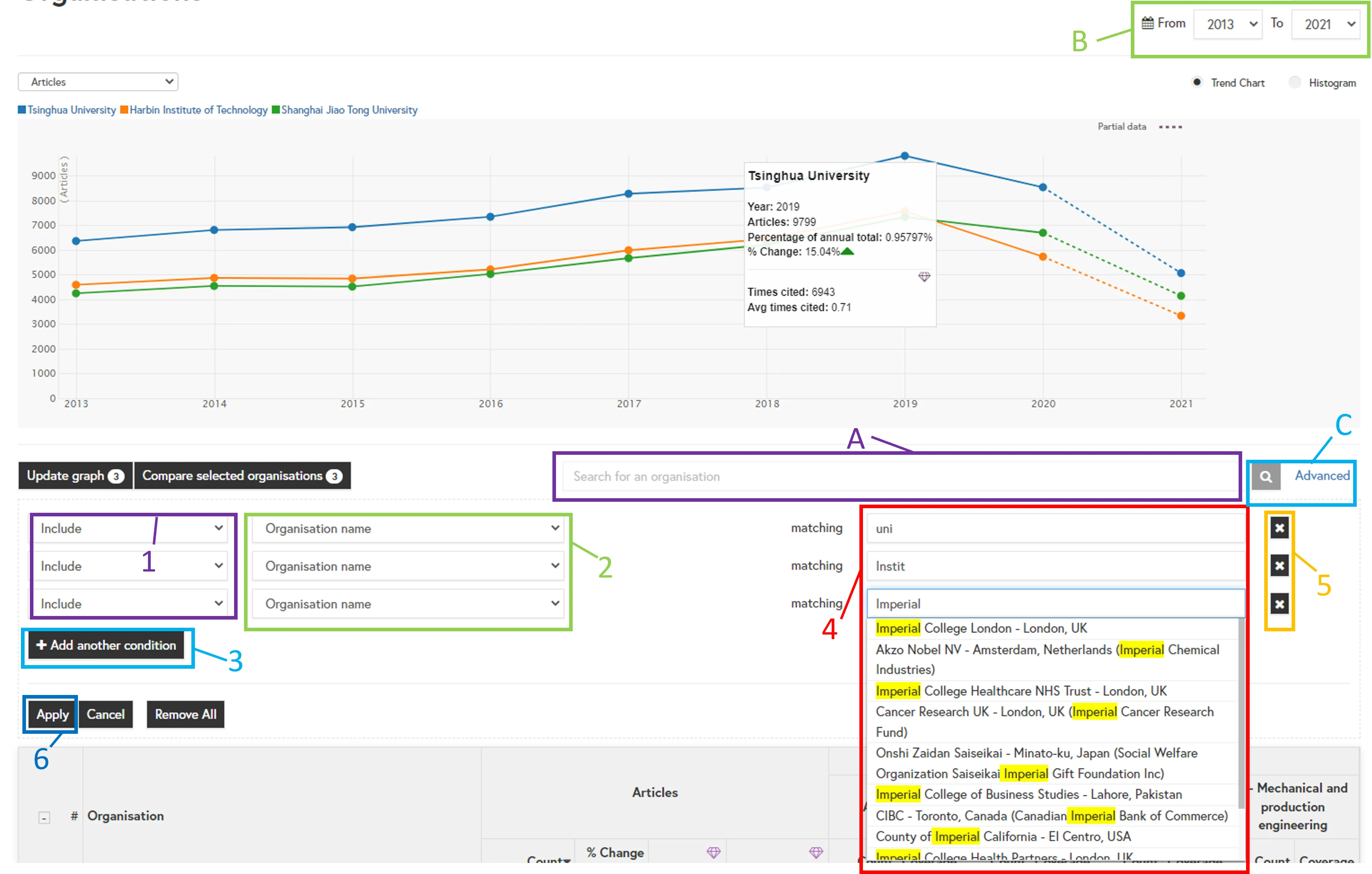Understanding the view
Follow the guide below or skip to our walkthrough video.

Organisation and count column (A): Click on an organisation name to go to the corresponding organisation profile page. Organisations by default appear listed in order of total research output with the highest “Count”, i.e. total number of articles indexed in Inspec, at the top. Reorder your results by clicking on “Count” to order your results with the highest or lowest number of articles at the top.
Inspec Classification Counts columns (B): The number of articles is also shown by Inspec classifications: A- Physics, B- Electrical engineering and electronics, C- Computers and control, E- Mechanical and production engineering. Click on one of the subject classification counts to reorder your results by that subject e.g. A- Physics.
Classification Coverage columns (C): The coverage column indicates the breadth of coverage the articles cover under each classification e.g. If the articles cover half of the 2,265 Physics classification codes in Inspec, the coverage will be 50%. This is a good indicator of how specialised an organisation’s research output is; two organisations may publish the same number of articles within ‘Physics’ but one could be a general research organisation, whereas the other only publishes on, for example, astronomy.
Citation columns (D) - Inspec Analytics Plus only: The times cited column shows the total number of times these articles have been cited. The average times cited shows the average number of citations per article. Click on the times cited column, average times cited column or citation level score column to reorder your results by most cited or highest average citations.
Percentage Change column (E): The percentage change column in the table shows the total change in article output for each organisation over the time period. This can help to identify which organisations have the fastest growing output. Click on the “% change” title at the top of the column to reorder your results by ascending or descending percentage change.
Update Comparison Graph (F): To compare output for a number of organisations, select your chosen organisations and click “update graph”. The line graph at the top will display the research output for each of your selected organisations over time. Hover over the points to display the number of articles and percentage change for each year. Inspec Analytics Plus only: citations are also displayed when hovering over points in the graph.
Compare selected organisations (G): Select up to five organisations from your results and click “Compare selected organisations” to open the organisation comparison page.
Change Chart Type (H): To display your results as a histogram chart, select the toggle at the top. Inspec Analytics Plus only: Use the drop-down to update the histogram to show the number of articles, number of citations or the average number of citations.
Navigating your results
View and Find Results: Reveal more results per page using the drop-down at the bottom of the table or jump to a row by typing a row number in the “Go to” box.
Page Buttons: Click through to the next page using the arrows.
Filtering your search

Search Bar (A): Search for an organisation using the search box at the top of the table. Start typing to see suggestions or click search to see results including your search term.
Date Filters (B): Filter the date range of your results using the “From” and “To” drop-down selections.
Advanced Search (C): Click “Advanced” to see advanced search options:
Advanced Search (1): Use the drop-down to select “Include” or “Exclude” search terms.
Advanced Search (2): Search with an organisation name, location or organisation type.
Advanced Search (3): Add multiple conditions. Each condition will be treated as “OR”.
Advanced Search (4): Search for whole words, partial words or start typing to see suggestions and select an organisation.
Advanced Search (5): Remove conditions by clicking on the corresponding “X” or by clicking “remove all”.
Advanced Search (6): Click “Apply” to see your results.
Exporting your insights
Click on "Export as PDF" at the top of the page to download your current view. The PDF includes a link to your view so you can return directly to the data in the future.
Inspec Analytics Plus only: You can also choose to download your insights as an Excel file.
